
28 minute read
Growing into the Future: Reconnecting with Food in Esk’etemc
Left to Right: Robert Johnson and Jonathan Hand smile as they finish building 15 new garden boxes for the Community Garden site. Photo: Jonathan Hand

Advertisement
Mary Daniels makes a plan to plant seeds at the Esk’etemc Community Garden site. Photo: Jonathan Hand
Springtime this year arrived unlike most, flooding our lives with uncertainty as we rallied to mitigate the risks of a global pandemic. While overcoming the many hardships created by COVID-19, we have also begun to see the seeds sowed for the better. Just as winter fades to the promise of spring, adversity is often the starting point for growth and newness. We can understand this same lesson from watching fire sweep the land and create balance in the ecosystem, or fasting in the sweat lodge to pray for clarity and guidance—suffering can bring about a lasting imprint as we learn to move forward.
One of the positive changes we are experiencing in Esk’etemc amidst the pandemic is a reconnection with our food. We were aware that we relied on outside sources of food as a community, but that fact is easy to take for granted when the grocery stores are fully stocked most of the time. With the food supply chain put into question by COVID-19, there is now a bottom-up movement in Esk’et towards reinvigorating our food culture and revisiting our history of food production.
Esk’etemc have a rich history of selfsufficiency and a deep understanding of how
Article by Jonathan Hand
to look after the land to receive a bounty from it. People here had the knowledge and skills to manage soil and livestock, grow food, and build and maintain root cellars, and a myriad of other abilities that allowed them to provide for themselves and their families. Many community members alive today remember the short summer months they spent at home while not in residential school, helping their families and elders prepare gardens and root cellars. Although residential school greatly impacted the passage of cultural and traditional knowledge for Esk’etemc and other First Nations, the knowledge to grow and store food has silently persisted. With pressure from the pandemic, that capacity for self-sufficiency has started to awaken once again.
In the early stages of the pandemic, I had a conversation with my good friend Robert Johnson about a vision for the community, where people were working the land again and inspiring others to do the same. Since then, the community has achieved more than I imagined. Many households in the community have taken it upon themselves to build garden boxes, the Sxoxomic School worked with students at home to plant seeds, and fields are being plowed and used for the first time in years. The local community garden box area nearly doubled its number of garden boxes this year and will be growing food to sell through the local store at an affordable cost. Moreover, the Esk’etemc Band is supporting community members with garden box kits at an affordable price, with over 60 households signed up. Robert and I became part of the movement ourselves, building a garden area in a shared space with Robert’s neighbour, bringing all of our families together in a collective effort. We used salvaged logs from the nearby Mayfield area that burned in 2019, local soil, and local manure, and we cleared the land with fire in the spring, making the process extremely rewarding on a personal and holistic level.
All of these efforts are part of a bigger vision that Esk’etemc has to become food resilient and self-governing. The unexpected hardship of COVID-19 propelled us forward and has given us a starting point to revisit our large-scale agriculture goals and how we can make agriculture programs thrive on our land base. Esk’etemc believe in using the land to protect and steward it for all walks of life, thus food production represents an immense opportunity to begin managing the land more sustainably while also creating meaningful

employment opportunities in the food sector for our people.
While we are starting small with a household resurgence of gardening, I believe we are making a major step forward towards our overarching goals of being self-sufficient as a community. We are also seeing how food can bring our families and community members together to share knowledge and skills, and
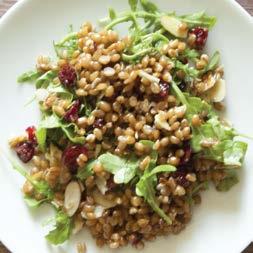
Wheatberries are a delicious, chewy, wholesome grain that make a hearty alternative to couscous or quinoa. They are fibrous and filling, but with a light dressing and some summer herbs can make a great side salad that doubles as a main dish. This recipe has dairy and vegan options and options for adding nuts versus seeds. In our home, serve this up with seasoned tofu or seitan chunks for the three vegetarians and broiled chicken for the meat lover. Enjoy! simply enjoy time together. Even if large-scale plans are years away from being a reality, I feel in my heart that something deeply important is happening in Esk’etemc and that this time of adversity and uncertainty will be a pivotal moment in our story. -GG
Jonathan Hand is a Newfoundlander who has been living and working in Esk’et since
Log garden boxes all finished, lined up and ready to be filled with dirt at the family garden. Photo: Jonathan Hand

2018. He has a degree in marine biology and sustainability from Dalhousie University, as well as a master’s degree in development practice from the University of Waterloo. He works in communications for Esk’etemc and is honoured to live, learn, and serve in the community.
Wheatberry Salad Recipe by Jessica Kirby
INGREDIENTS
1 1/4 cup wheatberries, dry 3 1/2 cups water 1/4 cup green onions, chopped 1/2 cup cherry tomatoes, halved 1 stick celery, diced 1/4 cup walnuts, pumpkin seeds, or sunflower seeds 1/4-1/2 cup sour cream or full fat plain yogurt, or 1/4 cup olive oil for vegan 1 Tbsp lemon juice 1 tsp garlic powder 2 tsp chili powder 1 pinch salt, generous salt and pepper to taste fresh herbs of choice—I usually raid my herb garden for lemon thyme, oregano, parsley, pineapple sage, and/or garlic chives but this part is totally up to you and what you have on hand.
METHOD
1. Preheat oven to 375 degrees F. Place raw wheatberries on a pan and roast in the oven until golden and fragrant, about 6-8 minutes. 2. Bring 3 1/2 cups of water to a boil with a generous pinch of salt. Add the wheatberries and reduce heat to medium. Stir occasionally and start checking for doneness around 25-30 minutes. When the wheatberries are soft and chewy, rinse in a strainer with cold water and cool. 3. When the berries are cool, at the onions, tomato, celery, and nuts or seeds. Mix thoroughly. 4.Make your dressing. If you are using the dairy option, mix your sour cream or yogurt into the salad ensuring all ingredients are coated. Add lemon juice and stir to combine. Add seasoning, stir, and adjust to taste. You can add a little spice—cayenne or hot sauce —at the end if that suits you. If using the vegan option, combine oil, lemon juice, garlic, chili powder, and salt and pepper in a small bowl and mix into salad.
Part of the Cariboo Regional District’s Solid Waste Info Series: Becoming Waste Wise
Spring is the perfect time to start composting or ramp up production of nutrient rich soil in your existing compost pile. A healthy compost pile will be moist, have a good balance of carbon to nitrogen, and have a regular supply of oxygen. If your compost isn’t breaking down, it’s because one or all of these things are missing. Compost piles should be layered with veggie/fruit waste and a carbon source, like leaves. The material should be aerated regularly—every week, ideally. This can be done with a shovel, but a soil turner is easier to use. If the compost seems too dry, you can add some water to it on a weekly basis, as well.
Why should you compost? Because leaving your veggie and fruit waste in the garbage creates methane gas, increases landfill leachate production, takes up space in the landfill, costs money to transport, and wastes the nutrient content of the food.
In the oxygen deprived environment of the landfill, organics don’t get a chance to break down into compost or soil; rather, they slowly decompose and release methane gas in the
Article by Tera Grady
process, which is a greenhouse gas 21 times stronger than carbon dioxide when related to climate change.
All landfills create leachate, but leachate production can be limited by the amount of moisture present in the waste. Organics contain over 60 percent moisture (by weight), which turns into leachate as the organics decompose. The leachate travels through the other waste in the landfill and collects contaminants. If the landfill doesn’t have a leachate collection system, these contaminants could move into the land.If the landfill does have a leachate collection system, the contaminants must be managed or removed, which is a costly process.
The lifespan of a landfill is measured in volume by how many years of waste will fit into the existing landfill footprint. If we can reduce the amount of waste going into each of our landfills, it gives us more years of use—an excellent reason to divert as much as we can from our landfills.
Organic waste is heavy because of the moisture content, and waste disposed of at transfer stations is hauled to a regional landfill, which is paid for by the tonne. This is another good incentive to divert the heavy organics out of our garbage and into our yards.
The nutrients from food waste cannot be harnessed if they are mixed up in landfill leachate, but they can in your compost. Even if you only turn your finished compost out onto your lawn or place it around the base of the trees or shrubs in your yard, the nutrients will be put to good use.
The CRD and its member municipalities want to help you change your food waste disposal habits and will be offering subsidized backyard composters and counter top containers in 2020. Email talktrash@cariboord.bc.ca to get the details, or call the CRD at (250) 392-3351 or toll-free 1-800-665-1636.
Learn more by following us on Facebook at www.facebook.com/caribooregion or visit us online at www.cariboord.ca. For more information on the Waste Wise Program, call (250) 398-7929. You can also find more details on Waste Wise activities and events at ccconserv.org. -GG

Williams Lake Garden Club
Bi-annual Garden Tour Going Ahead July 11 A fter much discussion, the Williams Lake Garden Club has decided to go ahead with its bi-annual, self-guided garden tour. If you like flowers, mark July 11 (10 a.m.to 4 p.m.) on your calendar.
The tour showcases the region’s loveliest flower gardens in Russett Bluff and Williams Lake proper. Participation is by donation and jars will be available at each garden. Tickets are recommended and can be reserved by contacting Nola at (250) 392-6858. Tickets will be emailed or mailed and include a map showing the location and description of each garden. At each garden there will also be quilts, music, pottery, paintings, or garden art for your enjoyment.
Proceeds will go to a local charity.
The garden tour is taking a variety of safety measures to ensure visitors are safe. Hand sanitizer will be available at the entrance to each garden. Masks will be worn by the volunteers and visitors may wear masks at their discretion. The Williams Lake Garden Club will be ensuring that the appropriate number of people will be allowed into each garden, and a volunteer will be circulating to be sure social distancing is in effect.
The club is hosting its bi-annual garden tour thanks to the volunteer efforts of the tour co-ordinator, Deb Radolla. Thank you in advance to those wonderful gardeners who have agreed to open their gardens for viewing.
The Williams Lake Garden Club meets once a month and offers sessions that appeal to all gardeners, new and experienced. For more information about the Williams Lake Garden Club, including the tour, follow the group on Facebook and watch for posters about the event.
Hope to see you there! -GG
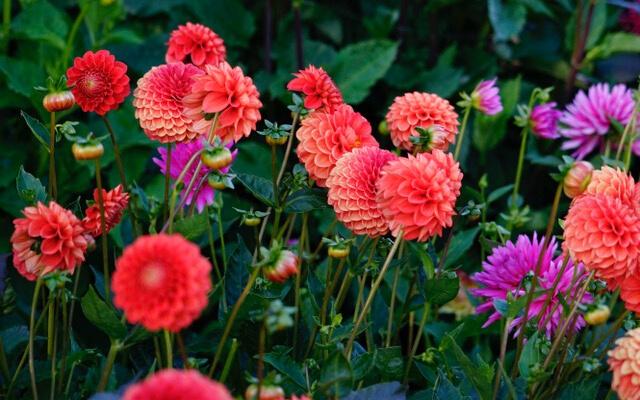

Article by Jessica Kirby
The talk of the town is isolation and restrictions. When will it end? What will new normal look like? Since no one really knows for sure, it might make better sense to stay present and see what we can learn. The most important thing that comes from this will be whether we— meaning governments, health authorities, the human race—take heed of the lessons that abound in this scenario and apply them in preparing for next time. Because there will be a next time. It might be another pandemic or a global catastrophe, or an environmental crisis, or an economic meltdown, but rest assured, it will be something.
So, what have we learned?
Isolation is having important climate effects, but whether they will last is up to us. About a third of the world’s population is in lockdown. Goats are running through the streets in Wales, seals and dolphins are turning up in harbours where they haven’t been seen for decades, skies are clearing in big cities from Los Angeles to Venice, and overall pollution is down 25% in China alone.
Of course, there are adverse effects. Medical supplies, such as face masks and gloves, are washing up on beaches around the world. Climate summits have been postponed. The trend moving forward will be video conferencing instead of face-toface conferences, and we all know how a screen between us dampens the impact of an interaction.
So, what have we learned? Use less, recycle more? Talk less, but make every word count? Take small steps but take them relentlessly? If this pandemic has taught us anything it is that we are alone in nothing.
Families are exploring ways to work and learn from home, together, returning to the roots of humanity. Nearly 5 million Canadians are working from home right now and between 52% and 73%, depending on the

province, wish it to stay that way. How will that change the dynamic in the home, the way we choose our careers, and the metrics we use to evaluate the value of work? Children have only been educated in rows using standardized curriculum for the length of a heartbeat in the human story, but the habits are set and some families are struggling to balance educating their children, working, and household responsibilities. Members of families are learning to carve out their spaces, interact with one another, practice patience, and develop self-discipline but some feel they can’t move another step forward in the current status.
So, what have we learned? Make room for family time? Shed the unnecessary rushing? Stop glorifying busy-ness? Love more and complain less? Remember, those kids won’t need you forever.
Since March, 2 million Canadians have lost their jobs and nine percent live below the poverty line. Nearly 12 percent have experienced a threat to their personal food security, and traffic at food banks is up 3 percent. Also since March, big box stores with the capacity to be deemed essential remain open while smaller “non-essential” local stores had to close their doors, some permanently. The Canadian Federation of Independent Business surveyed 10,969 Canadian small businesses and reported that 22 per cent of those had their revenue drop to $0 during the pandemic. Only half of those surveyed were confident their businesses would survive to the end of May. At the same time more than 6 million Canadians have applied for emergency income relief.
So, what have we learned? Is shopping local really more expensive? Should we value quality over quantity? Wants versus needs? Is excessive shopping a productive form of recreation? When a local business fails, that’s your neighbour failing. Are you okay with that?
Since COVID, Canadians have spent roughly 32 percent more time than normal outdoors. This number is an average since isolation in cities like Toronto and Vancouver saw more people stay completely in the house while smaller communities, such as Vancouver Island, saw people isolate outside on forested trails and in wild places. With nowhere to shop and no extracurricular activities, people looked within their homes for projects, crafts, and improvements, took up jogging or home gym workouts, and planned dreamy outdoor vacations in their own backyards.
So, what have we learned? Is it really that hard to stay in shape? Get fresh air? Unplug? Learn to value wild spaces? When this is all over, we must remember that the woods were there for us when we needed them the most.
The number one factor in staying the course and changing our behaviours is going to be supporting the economy. We want to believe we are au naturale in our thinking and that we would die on the environmental sword at any cost, but most of us know that if it came down to supporting our families we would do nearly anything to make sure our future is secure.
Here’s the thing: we can support our families and livelihoods and the environment all at once. It doesn’t have to be a choice. The decisions we make about our spending habits, travel agendas, and recreational activities will have imperative effects on the economy, our health, and the environment, and we can reconcile peace and security if we take a moment to ask the important questions.
So, what have we learned? -GG
Jessica Kirby is a freelance editor and writer covering the environment, lifestyles, and the built environment for publications across Canada and the United States. She can usually be found among piles of paper in her home office or in the Vancouver Island wilderness enjoying nature's incredible bounty.
New Strategies are Needed to Recover from the Pandemic
Article by Jim Cooperman
The pandemic has been a massive shock to humanity, and as a result, there may never be a return to the same lifestyle we have always deemed normal. In fact, the disease has exposed all the flaws in our society, and thus, it could become a catalyst for the changes needed to improve our lives. While most of the key decisions are made in Ottawa and Victoria, there are ways that regions like the British Columbia interior can change for the better.
The goal posts are shifting. For too long the mantra of continuous growth has been the driving force in the economy, as if we lived on an infinite planet where more of everything could continue forever. As society slowly emerges into a post-COVID world, the new buzzword is resilience, which communities now desire as they grapple with all the threats to our normalized way of life.
First and foremost are the risks to our food supply since most of it is either imported from the United States and Mexico or is dependent on foreign temporary farm workers. Fortunately, there is an abundant supply of quality arable land in much of the province that has the potential to feed all of us with ample more for export.
However, there are many obstacles that need to be addressed before sustainable agriculture can become a solution. Much of our farmland is underutilized and the costs are far too expensive for young people to purchase land. Solutions could include leaseto-purchase opportunities, cooperatives, and revising the rules to allow for large farms to be
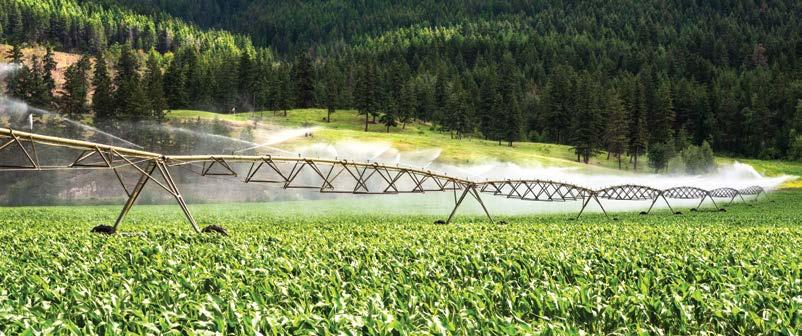
subdivided into smaller acreages that would be farmed more intensively.
In addition to providing more opportunities for growing food, we need to revise our diets to include more of the types of food we can grow and store locally. A classic example is the standard head of lettuce, which is a basic staple for most families. While there is no shortage of greens during the growing season, throughout the winter fresh greens can only be grown here under lights. Cabbage is the ideal replacement in the winter, as it stores well under refrigeration and it is more nutritious and flavourful.
In addition to food, fabulous trees also grow in the interior. As the forest industry continues to weaken due to a combination of a declining timber supply and job-killing mechanization, the need for seedlings increases. More tree nurseries are needed, given the demand due to forest fires, pests, and logging.
Tourism, which has long been a key part of the economy, is taking a hit from the pandemic and its recovery may be hampered for a few years until there are fewer risks from travel and more people can afford to enjoy a vacation again. A mitigation strategy could be pursued that would help to expand the tourism season by promoting the many hiking and biking trails, as well as by building more trails.
With so many people now working from home, the nature of work will likely change for the better once we are free from the pandemic. It is possible that many people will want to exit from the cities to live in rural communities, where they can enjoy a healthier lifestyle and more recreational opportunities, andstill be able to work remotely via the internet.
Many experts are calling for a green recovery that focuses on investments in technologies and infrastructure that help reduce carbon emissions. Ecosystem restoration is part of the federal plan, and it is possible that funding could be secured to restore more of the Salmon River riparian areas.
Achieving greater resilience would include improving our ability to cope with the stress from climate change and economic malaise, as well as from infectious diseases. Economic and social planning that encourages greater self-sufficiency, better food security, more affordable housing, and a higher level of social cohesiveness would help to ensure that British Columbia remains one of the best places in the world to live. -GG
Jim Cooperman was a provincial forest activist with the BC Environmental Network during the turbulent 1990s. He now focuses on local issues in the Shuswap, where he has lived on a rural property for 50 years. His bioregional book, Everything Shuswap, is a local bestseller.
Entwined Liberation: A COVID Awakening

Article by Margaret-Anne Enders
I’m sure you have heard it said at least once during the past couple of months of pandemic time—this is a time of great possibility. People say it with hope, with excitement, with the keenness of a new idea. Let’s be honest, though. This is nothing new. It has always been a time of great possibility. It’s just that we can see it more clearly now that the “normal” lenses have been knocked off of our faces. People are open to both the possibility and the necessity of change.
There is no denying the need for change. Climate change and the continued growth of the fossil fuel industry threaten the future of the planet and its inhabitants—including humans, to be clear. Here in Canada, the third best country in which to live, according to the 2019 Best Countries Report, 20 percent of children live in poverty, with the number rising to 47 percent for children living in First Nations communities. And, in a country that internationally prides itself on justice and fairness, our rates of incarceration, school suspensions, and children-in-care are skewed to the disadvantage of people of colour and Indigenous folks. We can do better, can’t we?
It is in this spirit of openness and desperation that I turn to the words of Lilla Watson, an Indigenous Australian artist and academic, and her activist community: “If you have come here to help me, you are wasting your time. But if you have come because your liberation is bound up with mine, then let us work together.”
While the context is somewhat different, the COVID-19 pandemic wakes us up to the fact that we are, in a sense, all in this together. It is clear that our individual health and safety is bound together with the health and safety of all. Of course, it’s not that simple. Economically marginalized groups are harder hit by the virus. Isolation is not so easy or even achievable in crowded housing, care centres, and prisons. The economic downturn will adversely affect those with fewer financial resources. But the fact remains—going forward, we will all be safer if everyone is taken care of. And indeed, that has been the call all along. The major world religions, standing the test of time, all advocate for some form of the law of reciprocity: treat others as you would like to be treated. Basically, take care of one another, respect each other, work for the good of all. And we have seen, when there is political and social will, there are money and resources available to take care of everyone.
So, what if we took seriously the idea that our liberation is a collective endeavour, that none of us will truly be free, fed, educated, safe, and healthy until we all are free, fed, educated, safe, and healthy? Imagine: not that we must work together out of guilt or fear of dire consequences, but that we wanted to work together, out of desire for new relationships and learning, for the thriving and health of all cultures, beings, and the planet. This is an opportunity for those of us with different sorts of privilege (economic, racial, gender, etc.) to amplify the voices of those on the margins. We can even begin to sacrifice a little for the sake of all—things like decreasing our carbon footprint by limiting non-essential air travel and giving our time to learn about issues of inequity in our community and then working for change.
As we move through this challenging and chaotic time, there are signs that spark great hope within my soul:
Indigenous wisdom from all parts of the globe coming to the forefront
Financial support available to most people in need
Lower levels of factory emissions and decreased transportation leading to cleaner air and reduced pollution Widespread conversations about universal basic income
Increased government and community support of small businesses
Creative connections in social, spiritual, and economic realms: virtual powwows, Zoom weddings, the return of the drive-in
Innovations in medicine and health care
The realization that we can clearly use fewer fossil fuels
The possibility of smaller class sizes and more opportunities for outdoor learning
Imaginative policy ideas like the Green New Deal
The words of the president of the European Commission, “As we come out of the crisis, we must not fall into old habits. We must not hold onto yesterday’s economy as we rebuild.”
The collective consciousness is active and ripe for change. There are challenges, to be sure, and positive change is not inevitable— so let’s keep dreaming and advocating. Possibilities need champions to become realities. Pick a passion, even one, and put in some time and energy to help bring it to fruition in our changing world. As Lilla Watson urges, “Let us work together.” -GG
Margaret-Anne Enders is a parent, a homegardener, and a lover of peaceful spaces in nature. She works in the areas of racial justice, reconciliation, and community development. Margaret-Anne lives on traditional unceded Secwepemc territory and is thankful for the presence and teachings of the local and surrounding Secwepemc, Tsilhqot’in, and Dakelh-Dene people.







Something Magical

Article by Terri Smith
Magical Unicorn. Photo: Terri Smith
Ibelieve creativity is important. When we are creating, we are living in the moment. The worries and cares of life can be set aside, and we can allow ourselves to be captivated by a sense of wonder and excitement. I believed this was important even before the world as we knew it came to a standstill. Now that so much is so uncertain, I believe it is still important, perhaps now more than ever.
I have been teaching needle-felting classes for over two years and have been felting for a little over a decade. I love the immediacy of working with fibres. I love the textures and the colours, and even the smell of the wool. I love to create magical creatures and landscapes, and I love to help others create their own magical works of art. I especially love the moment when someone’s eyes light up with joy over what they have created, and to hear someone exclaim: “I never knew I was creative!”
When I began teaching workshops a few years ago I purchased supplies locally until our local wool shop closed. After ordering online from a few Canadian companies I realized most of them were ordering from overseas anyway so I went further up the supply chain and now order most of my wool and fibres from a family-run business in Italy called DHG that carries a beautiful selection of mulesingfree wool. I didn’t even know what this meant until I found this company. ‘Mulesing’ is the removal of strips of wool-bearing skin from around the buttocks of a lamb to prevent flystrike. Flystrike is also a terrible thing, but there are other ways to prevent it.
Once I began ordering large quantities of wool, I began selling felting supplies, and it makes me so happy to be able to share my love of fibres.
In every aspect of my new business I am striving to be as sustainable as possible. I order my wool in large quantities to reduce
Fairy mushroom house. Photo: Terri Smith
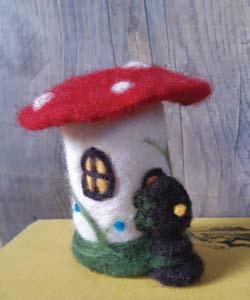
packaging, and I seek out Canadian and local fibres wherever possible. When I teach local classes, I package supplies in repurposed containers, mostly plastic clamshells that formerly held organic vegetables. I reuse the thick plastic that my wool arrives in by cutting it into smaller pieces and sewing it into smaller bags to contain the felting kits that I sell.
I am sourcing recycled packaging for online orders, and I am looking into imaginative box designs that could double as playsets or display units. I enjoy the challenge of thinking about how every bit of what someone orders can be used and reused. While at first I gave out cleaning sponges to use as cheap felting pads, I have now begun sewing my own felting pads from premade felt I order from the same company. These last for years and are not made from plastic—and they are also beautiful!
There are cheaper and easier ways to begin a business, but I am trying to build a business


Felted red panda. Photo: Terri Smith
A suitcase full of wool. Photo: Terri Smith

with a conscience. I want to be able to feel good about what I am selling, and I want people to feel good about ordering from me.
Now that the world has changed so much, I believe that creative play can help us more than ever. I am now learning how to make videos so I can teach workshops online.
Making a small, magical sculpture from wool may not seem like an important thing to do. But what I have noticed repeatedly as we have moved through this difficult time, is that creativity is what keeps us going. Online, there are so many articles and memes that fill us with dread, with fear, and even anger—but the things that bring us hope and make us feel good are often examples of people being creative.
I also love to be able to make the gifts I give to people. Something you have taken the time to make yourself is an extra special gift to give someone.
Terri hugging her felted slug. Photo: Mark Rupp
I struggled with what to call my new business. I had all sorts of ideas, but none seemed right. I only knew that the name needed to be something magical as so much of what inspires me is the magical world of nature and fairy tales. A friend of mine was trying to help me decide on a name and said, “Because it’s you, I really feel like it needs to be something magical” and suddenly we both heard it: Something Magical. And who doesn’t like a good pun?
I believe everyone really does need something magical in their life. I hope I can help you with that!
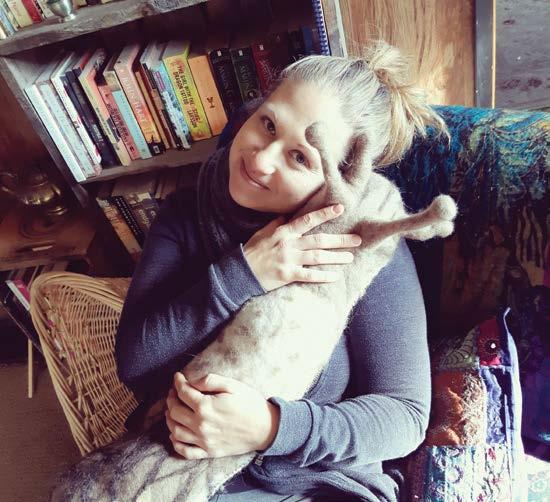
If you want to find me, my website is under construction, but will soon be found at www. somethingmagical.ca. In the meantime, I am on Facebook and Instagram both at: SomethingMagicalByTerri. -GG
Terri Smith is an artist, educator, gardener, burlesque performer, and sometimes reluctant writer living in Quesnel, BC. She teaches workshops on gardening and needle felting and can be found on Facebook at Road’s End Vegetable Company or Something Magical.






